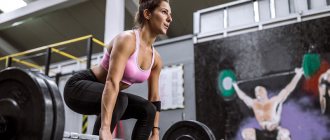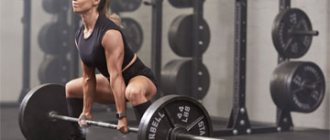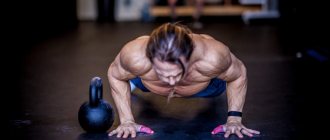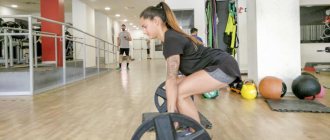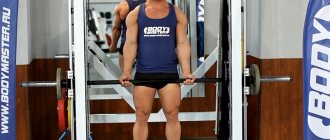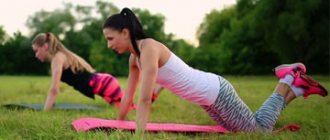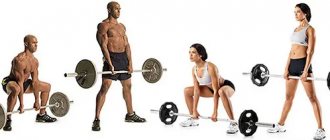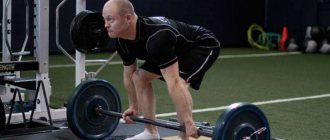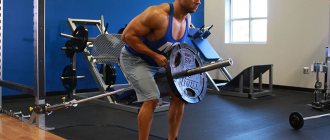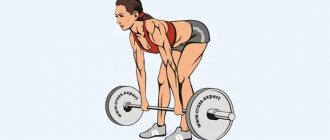The Romanian deadlift or Romanian barbell deadlift is a challenging but very effective strength exercise that helps develop your back muscles, hamstrings, and glutes.
If you have been working out in the gym for a long time and want to move on to serious strength training, then be sure to pay attention to this exercise. However, you should be extremely careful.
The Romanian deadlift with a barbell is a rather traumatic exercise, so you should pay as much attention as possible to the correct execution and safety precautions. And under no circumstances ignore safety rules.
We'll tell you everything now.
Execution technique
The Romanian deadlift with a barbell or dumbbells for girls and women is a basic multi-joint exercise. Heavy weights are used during training
Therefore, observing the correct technique for performing this athletic movement is extremely important not only from the point of view of achieving sports results, but also maintaining the health of the practitioner.
Preparing for the exercise
The Romanian barbell deadlift creates static tension in most of the major muscle groups in the upper body. The greatest load falls on the back muscles and in particular on the long extensors. To reduce the risk of injury and maintain the functionality of the musculoskeletal system, it is necessary to warm up before each workout.
You should start your preparation for a sports activity with a light jog or walk. This stage can last from 15 to 30 minutes. In a fitness club or gym, walking outside can be replaced with a treadmill.
The complex is performed strictly in the established sequence.
- Rotational movements of the head - 10-15 revolutions in each direction.
- Rotate your arms at the shoulder joints and swing your arms behind your head and in front of you – 10-15 repetitions of each exercise.
- Rotational movements in the elbow joints and hands – 10-15 times.
- Body tilts in different directions in a circle - 10-15 repetitions.
- Squats with arms straightened in front of the chest – 20-25 times.
Before performing the Romanian barbell deadlift, you must perform several approaches on the hyperextension machine. If this sports equipment is not available in the gym, it can be replaced by bending the body forward. When performing this movement, your back should be straight.
Taking the starting position
After warming up, you can begin performing Romanian deadlifts with a barbell. To do this, you need to take the correct starting position, which will ensure safe removal of the sports equipment from the racks. Also, the correct starting position ensures an anatomically correct technique for performing the exercise.
It’s worth starting with the position of the body relative to the barbell. If the equipment is on support stands, then you need to get as close to it as possible. The shin almost touches the bar. The feet should be parallel to each other. This will avoid dangerous rotation of the knee joint when moving down. The distance between the feet does not exceed shoulder width.
Next, you should prepare to tear the bar off the support. Without changing the starting position, you should place your hands on the bar slightly wider than your shoulders, and your shoulder blades should be brought together. This will prevent the thoracic spine from rounding. The back is straight and level. The pelvis is slightly laid back. Knees slightly bent.
Checking the position
After completing all the described actions, you can begin a test lift of the barbell with weights. This procedure allows you to check the correctness of the operations performed.
In this case, during short muscle tension, it is necessary to pay attention to the following aspects:
- Ability to maintain balance. If, after attempting to remove the barbell from the supports, a slight swaying or instability is felt, then the center of gravity of the athlete-barbell system has been selected incorrectly. To correct this situation, it is necessary to position the legs a little closer or further from the vertical axis of the sports equipment.
- Grip width. If the grip width is insufficient, it becomes difficult to remove the barbell from the racks. Hands touch knees and thighs. The movement is performed incorrectly. With an excessive grip width, the emphasis of the load shifts to the back muscles. They may not be able to withstand the stress. As a result, the shoulders move forward and the lower back rounds.
Moving Down
Having removed the apparatus from the racks and straightened up, the girl or woman can begin the main part of the exercise - the downward movement. At this stage, the gluteal muscles and the back of the thigh are stretched.
While driving, the following rules must be observed:
- The barbell is lowered slowly to a count of 3-4.
- The bar of the sports equipment moves along the thigh and upper part of the lower leg, but does not touch them.
- The downward movement is carried out by moving the pelvis back.
- The knees should be fixed in one position. They cannot be moved forward or to the sides.
- Rounding of the back is not allowed.
Upward movement
Lifting the barbell upward should also be done smoothly. Jerks are not allowed. The movement should be performed using the muscles of the legs and buttocks.
Useful tips
Most recommendations concern technique and safety of performing the exercise. You can't train through pain. If you feel discomfort in the muscles, exercise should be suspended. The traction of an elastic expander is less dangerous than barbells or dumbbells. But safety rules cannot be neglected.
When performing tilted rows, you need to straighten your body using the force of the femoral muscles, not the lumbar muscles. The abdominal muscles are constantly kept in a tense state to avoid sprains. You should always keep your back straight and your knees slightly bent.
When performing a classic deadlift, it is important to synchronize the work of the abdominal, femoral and gluteal muscle groups, which together overcome the external resistance of the sports accessory. When working out with an elastic band, the only task of the hands is to hold the band, and not to help lift it towards the chest.
Deadlift for girls: execution technique
Next, we will look in more detail at the features of performing different types of this exercise, and also figure out which deadlift is preferable for women. The following styles (methods) of traction are distinguished:
- Classic (regular).
- Sumo.
- Deadlift on straight legs (Romanian).
- Dead.
- In the classic version, the legs are positioned shoulder-width apart, the hands are on the bar at the level of the legs.
- With the sumo variation, the legs are spread as wide as possible (ideally from plate to plate), and the hands are on the bar between the legs, slightly narrower than shoulder width.
Execution technique
- We come very close (right next to) the bar. Position – half squat.
- We spread our feet apart by about 45%, resting our heels on the floor. (If positioned correctly, you will be able to wiggle your toes without leaving your heels off the floor).
- We bend our legs at the knees and squat so that our thighs are horizontal to the floor.
- We bend our back forward. Don't forget that it is perfectly smooth and taut. Even the slightest rounding of it is not allowed.
- The pelvis is slightly raised up, protruding.
- The head is raised up, the gaze is into the distance. You can choose one point on the wall and fix your gaze on it.
- We grasp the barbell with a different grip (one palm looks down, the other looks up). This position of the hands will not allow the bar to spin or slip out.
- Inhale and lift the barbell, sliding along your hips, straightening your legs and torso.
- We stop when the bar reaches the middle of the thigh.
- We move the shoulder blades back slightly.
- At the end we exhale.
- Repeat the required number of times.
If for the classic version and the sumo deadlift, 50% of the exercise consists of squatting, then with the Romanian deadlift on straight legs, the squat is performed slightly (bending the knees by 5 degrees is acceptable). Thanks to straight legs, the entire back of the thigh, as well as the gluteal muscles, is actively worked out.
The deadlift differs from the Romanian deadlift in that the exercise is performed exclusively on straight legs, without allowing bending in the knees - a squat. Performing deadlifts in this form perfectly tightens the muscles under the buttocks.
Deadlifts require very good stretching, so they can only be performed by those who have sufficient physical training.
Deadlifts with dumbbells are well suited for beginners, since when performing them, the load on the muscles is not as strong as when performing deadlifts with a barbell. The classic version of performing deadlifts with dumbbells is as follows:
- Feet shoulder width apart. Dumbbells are located near the legs.
- The gaze is directed forward, the chin is raised.
- Lean forward with your knees slightly bent (half squat) to pick up the dumbbells. Remember that your back is straight, tense and fixed.
- The pelvis is protruded back, slightly raised.
- We straighten up, sliding the dumbbells along our thighs.
- The first mistake. The barbell (dumbbells) cannot be moved forward; it is necessary to slide the bar along the legs. If you do it incorrectly, you will put stress on your lower back.
- Error two. You can't round your back. Be sure to remember a tense, straight back and a slightly protruding pelvis.
- Error three. Strained knees - in order to protect the knee joints from injury, you can bend them slightly when bending over.
- Error four. Don't strain your arms. In this exercise, the arms serve as a “ligament” that transfers the power of the body to the barbell. You cannot make sudden jerks with your hands.
- Error five. Avoid overexertion. Trainers recommend performing this universal exercise once a week.
You can often come across the question of how to calculate deadlift weight for girls? There are no specific calculation formulas. The average woman deadlifts gradually reaches one body weight.
On the Internet you can find information that it is better for girls to perform sumo deadlifts, since in this case the muscles of the buttocks are better developed and tightened. This is not entirely correct. It will be more intelligent if a specialist tells you which deadlift is best for girls, taking into account the anatomical features of your body structure.
- Sumo deadlifts will be difficult for those with short legs or short stature.
- Also, coping with the sumo deadlift will not be easy for those who have insufficient stretching.
- But tall girls will not be entirely comfortable performing deadlifts in the classic version.
Performed in the same way as the previous version, but with dumbbells. Technically, this is easier, since the dumbbells can be placed on the sides of the body, thus bringing their center of gravity closer to the center of gravity of your body. The exercise is ideal for beginners. The downside is that the weights with dumbbells are always less than with a barbell.
Why is it called that?
The Romanian deadlift is an effective variation of the widely used deadlift. The exercise got its name thanks to the Romanian, Australian Olympic champion Nicu Vlad.
The athlete is a three-time world champion (1984, 1986, 1990). The weightlifter practiced deadlifts as an assistance exercise. It was the worldwide interest in the Olympic champion’s training program that made this variation of the deadlift popular all over the world and gave the exercise its name.
Errors
Classic mistakes when performing Romanian deadlifts:
- Rounded back. We repeat: throughout the ENTIRE exercise, the back should be straight, with a deflection in the lower back. If you can’t straighten it, it means you’ve taken on an unbearable burden, take less weight. To maintain your health and ensure safe exercise, keep your back straight. Correct execution of the technique is the key to your health. The picture is just asking for it????
Shoes. NO sneakers with foam soles, Airmaxes, sneakers, etc. In the article “Let's go to the gym: down with embarrassment!” It is described in detail and clearly how to choose shoes for strength training and cardio.
Don't regret it and buy 2 pairs of sneakers if your health is important to you. If you perform deadlifts (and squats and deadlifts) in sneakers NOT with flat soles (maximum 1 cm), then due to the “elevation” of the toes relative to the floor, there will not be proper stability of the “support lever” and the lower back will suffer.
Breath. This point applies to all exercises. Many people are so focused on doing the exercise that they completely forget to breathe. In strength exercises, everything depends on muscle tension - it is recommended to exhale at the moment of greatest muscle effort, and inhale at the moment of the least.
The main rule in this case is not to hold your breath for many repeated sets! Holding your breath - especially during the most strenuous stage of the exercise (for example, deadlifts, bench presses, etc.) can cause a short-term loss of consciousness, because the brain may simply not have enough oxygen. In addition, holding your breath can significantly increase your blood pressure. So breathe freely, deeply and slowly, saturate your body with strength and oxygen!
If you are performing your ultimate maximum, then you are welcome to learn the correct breathing technique.
The bar should be very close to your feet. Just believe me, it’s anatomically more convenient and the load on the femoral biceps is felt many times better.
No different grips. Different grip - one of your hands (either) rests on the bar with a direct grip (i.e., in the direction away from you), the other with a reverse grip (sorry for the clumsy explanation).
Different grip
It is very undesirable on a regular basis. It will lead not only to imbalance, but also to back pain, because... the load is different. The multi-grip is used if it is difficult for you to pull any weight with a normal straight grip.
Classic grip
A different grip (sounds like the name of the animal in Harry Potter ????) creates an unnecessary “torque” moment in the spine, you can become significantly distorted and look like the hunchback from Notre Dame.
Which is better: a different grip or a classic grip? This barbell grip gives you an undeniable advantage in holding the bar in your hands. Since your hands are pointing towards each other, it will be more difficult for the bar to slip out of them than with a straight grip. Of course, sooner or later with heavy weights or weak forearms this will still happen, but much later compared to a straight grip.
BUT: you only have the moral right to use a different grip if you are a powerlifter and want to take on a new weight at a competition. If you are not an athlete, then you are a cheater and in the gym you simply follow the path of least resistance. Of course, it is more difficult to perform exercises with a classic grip, but at the same time you maintain symmetry in muscle load.
Due to the asymmetry of the grip, the back muscles experience an additional and not very natural load. At best, this can lead to asymmetrical muscle development, and at worst, it can increase the risk of muscle injury. It is better to pull lighter weights, but with a direct grip.
Keep your knees slightly bent throughout the entire movement. If your knees hurt when doing Romanian deadlifts, it means you are locking (straightening) them at the end point of the exercise.
Tips for implementation and beginner mistakes
This exercise cannot be called easy. The main mistake beginners make is that the barbell is pointed towards the floor, whereas throughout the entire movement it is necessary to press it against the shin.
So, to correctly perform the Romanian deadlift exercise, you need to grip the barbell with an overhand grip. If you carry a lot of weight, you may need wrist bands and a slight elevation to increase your range of motion. Legs should be bent at the knees, back straight, legs perpendicular to the floor.
Types of Romanian deadlifts
WITH DUMBBELLS OR WEIGHTS.
Everything is done in the same way as with a barbell, only here it is more difficult to keep the weight close to the legs. Read about this in a separate article.
ON ONE LEG.
We move the non-working leg slightly back. The dumbbell is taken in the opposite hand from the free leg. That is, if you lean on your right leg, take the dumbbell in your left hand. In this case, the right leg should be bent. Gently lean forward so that your torso is parallel to the floor. Repeat for the other leg.
This type of deadlift is used more for training balance and stability (we develop the vestibular apparatus), but not for muscle growth!
There are also variations in the crossover, the Romanian deadlift in Smith, with elastic bands (when you pull rubber instead of a barbell or dumbbells), in general, who knows what. There is also the Romanian straight leg deadlift.
The existence of this species confuses beginners even more when trying to figure out what is different from the “dead” one. Everything is the same as in the classic Romanian, only the legs are straight.
So, in this article we learned how to do Romanian deadlifts and I’m sure you were able to understand how it differs from other types.
In the following articles we will touch on a more detailed discussion of both the “dead” and classical deadlifts, and even such a type as “sumo”. Stay tuned! Bye bye…
comments powered by HyperComments
PS Subscribe to blog updates,
so you don't miss anything!
I also invite you to my Instagram
Exercise options
- Romanian traction with rubber shock absorbers. Due to the specifics of the projectile, more load goes into the back and buttocks, and a little less into the thigh biceps. This row is used if it is necessary to feel tension at the top point, or by those who do not know how to collect their back with dumbbells. The option may also be good for traveling;
- The King deadlift is an imitation of the Romanian deadlift without dumbbells, standing on one leg. Option for warming up, balance work or improving hip mobility. Suitable for anyone who wants to work out the back of their thighs without weights;
- Romanian deadlift with dumbbells on one leg. Allows you to shift the emphasis to the buttocks, due to the fact that it is performed with an emphasis on hip extension of the non-supporting leg
Nuances
In practice, there are about eight types of deadlifts. Not everyone understands the differences between them. It is worth remembering that the essence is to shift the loads, that is, for each variety the goal will be the development of certain muscles. Several features of the exercise in question should be noted:
- low weight of the projectile;
- short range of motion;
- maintaining the vertical position of the lower leg.
Before you start training, you should choose suitable shoes. It should be comfortable, without a heel or with a heel no thicker than 1 cm, with a flat and wide sole. Otherwise, the exercise may well end in a back injury.
If the weight is too heavy, a different grip is often used. However, this method can become traumatic, especially for the spine. Therefore, when using a different grip, it is advisable to reduce the number of repetitions or do the exercise using wrist straps.
A fairly common mistake when performing deadlifts is a rounded back. Such a mistake can be costly for the spine. You can insure yourself against unnecessary injuries if you carefully monitor the perfectly straight position of your back.
Often athletes neglect the correct approach to the barbell, as a result of which it moves at some distance from the legs
It is important to remember that the sports equipment should be located quite close to the legs or even touching them
Some athletes with powerful, well-developed hands mistakenly pull the barbell with them at the last stage of the exercise. This is strictly prohibited. The hands should only perform the function of holding the weight, and lifting the bar is carried out only through the work of the gluteal muscles and hamstrings.
What muscles are involved?
What muscles work during the Romanian deadlift? The exercise is rightfully recognized as one of the most effective for developing the muscles of the hip and back. The auxiliary muscles, the gluteal and calf muscles, are also included.
Basic load
The main load during the Romanian deadlift falls on:
- lumbar muscles;
- posterior thigh muscle group;
- trapezius muscles;
- quadriceps femoris, gluteus maximus.
Additional load
Also, let less stress be applied to the following muscles:
- anterior tibial;
- gluteus medius and minimus;
- deltoid;
- hip adductors.
An important feature of the Romanian deadlift is the large load on the lower back. Beginners are advised to first strengthen the lower back muscles with hyperextension. In addition, if you have back injuries, then it is wiser to abandon this exercise altogether.
During the training process, the largest muscle groups of the body are worked and significant weights are used. This helps produce enormous amounts of energy, and also stimulates the endocrine system and increases the release of growth hormone, testosterone and other anabolic hormones into the blood.
Differences between the Romanian deadlift and the classic deadlift
Trajectory of movement
When performing a traditional exercise, the athlete moves from bottom to top, fixes the barbell with outstretched arms and lowers it to the floor again. The back remains strictly straight. The classic strength element puts stress on the legs and back, but after performing it, pain often occurs.
The Romanian deadlift is a lighter version of the exercise. Keeping his back straight, the athlete does not lower the barbell completely to the floor, but only to the middle part of the shin. And the trajectory of movement, in contrast to classical traction, is “top-down”. Excessive load on the lumbar region is removed, reducing the risk of injury.
Effect
The classic deadlift increases the strength of the legs, makes the muscles and hips prominent and convex. The Romanian deadlift is aimed at working the thigh and gluteal muscles. This power element is not so difficult to perform, so it is perfect for girls.
Technique
There are at least eight varieties of deadlift, and many athletes do not know the features of each of them. The differences are in the displacement of loads, and the technique of performing the element also depends on this.
The Romanian deadlift should be performed according to the following scheme:
We fix the required weight on the apparatus and approach the bar. Keep your knees slightly bent at shoulder width
It is important that the feet are parallel to each other and the back is straight. We bend over (straight back!) and grab the barbell so that we can see our fingernails. We hold our hands slightly wider than our shoulders. We rise slowly
The spine should straighten completely, the shoulder blades should converge. Having inhaled the air with all your chest, we gently bend over, leaving the shoulder blades in a contracted position. The pelvis should lean back when performing the exercise. When tilted, the bar of the projectile is located at the front of the thighs. At the lowest point, the athlete should feel the maximum stretch in the thigh muscles. When the bar reaches the knees or (in a more complicated version) the middle part of the shin, we begin to return to a straight position. We obtain lifting energy by pushing off the floor with our feet.
Note! When performing the Romanian deadlift, fatigue should be felt in the hamstrings, not in the lower back: this is the key indicator of a correctly executed strength element. Technically, the Romanian deadlift is optimal for women; performing it regularly will add attractiveness to the buttocks and thighs
Technically, the Romanian deadlift is optimal for women; performing it regularly will add attractiveness to the buttocks and thighs.
The most common mistakes
The exercise cannot be called difficult, but many athletes, especially beginners, still make mistakes. Here are the most typical ones:
- When performing the Romanian deadlift, the back should always be straight and the muscles should be in a tense state. Flexing the spine is a dangerous mistake that can cause injury. In addition, with a rounded spine, the load is transferred from the hips and buttocks to the lower back, and training does not make any sense.
- On the first approach, you need to come close to the barbell, its bar should touch your legs. Many people who do this do not do this and get injured.
- The athlete holds the projectile by tensing the muscles of the forearms and hands. If the exercise is too difficult, you should not help yourself with your elbows, you just need to reduce the weight of the barbell.
Peculiarities
The main difference is that the bar should be lowered to mid-calf rather than to the floor. This feature allows you not to overload the lower back and increase the number of approaches during the exercise. This also reduces the likelihood of injury. Legs should be slightly bent. On the one hand, such minor changes that distinguish the Romanian barbell deadlift allow you to evenly distribute the load between the hips and buttocks.
Frequent mistakes during classes
To avoid unwanted consequences, you should listen to the advice of those who have already tried power lifting on themselves, as well as the recommendations of a trainer.
Did you know? Muscles are made up of muscle fibers. Each fiber is thinner than a human hair and can support a thousand times its own weight.
In their opinion, the most common mistakes are:
- Stabilization of the spine after the first grip of the barbell. Athletes lean on the barbell and grab it. Another name for the error is “soft back.” The correct movements are: stabilize the spine in a squat, push the pelvis back (hip flexion), grab the weight, lower and tense the hips.
- The position of the pelvis is as in deep squats. In the starting position, the athlete lowers the pelvis below the knees. Correct movement: the pelvis should be higher than the knees.
- Incorrect foot position. The athlete’s feet should be shoulder-width apart (if the feet are too wide or narrow, it will be uncomfortable to grip the barbell).
- Incorrect head position. Immediately take the starting position for the body, and only after that the head straightens up. The correct thing to do is this: starting from the starting position, the head should be a “continuation” of the spine.
- Incorrect lifting of the projectile. A powerlifter lifts weights: the hips move first, and only then does the bar begin to move. Correct execution of the exercise: straighten the knees, hips and lift the barbell at the same time. Synchronization of lifting the body with simultaneous straightening of the legs.
- Lean back to the top points of the pull. The athlete lifts the barbell, straightens his hips, but pushes them forward too much. This is what you need to do: lift the barbell, straighten your hips, tense your buttocks, quadriceps muscles, and then straighten your torso, which should be in line with your legs.
- False grip - using an alternative grip. Correct hold: the use of a hook grip when the fingers of one hand of the athlete holding the barbell are directed towards him, and the fingers of the other are directed away from him.
- Biceps curl. When lifting weights, your arms should not bend, as this risks tearing the biceps. The weight of the sports equipment should be lifted with straight arms.
- Wrong shoes. Sneakers with soft and thick soles are absolutely unsuitable for deadlifting. Buy shoes with flat, thick soles. Those few millimeters of unnecessary height play a very important role in lifting the weight.
Video: 5 Deadlift Mistakes
1. Dedicate a separate workout to deadlifts.
Oddly enough, many lifters do not include a separate workout for the most difficult exercise in their program.
For example, using the Westside Method, they do a variation of the squat or barbell on a max effort day and a box squat variation on a dynamic day. Then, of course, they can add weightlifting lifts or light acceleration deadlifts after the box squats, but this is always a secondary movement. And on max effort day, almost no one does heavy deadlifts.
And it was the same in our hall, but then we decided to make some changes. When my team and I decided to create a dedicated deadlift workout, the number of people lifting over 250kg increased dramatically. And five athletes deadlift more than 300 kg. Not a weak effect.
So, although this advice seems too obvious, dedicate an entire day to deadlifting in your program. At the same time, you don’t have to lift maximum weights every time; you can do volume or speed training, but one way or another you pay enough attention to the movement (and technique).
The subtleties of this type of physical activity
It is important to perform basic effective exercises such as deadlifts, Romanian rows and squats, strictly adhering to the technique, because the work uses serious weight, involves a large number of muscles and places a lot of stress on the spine. All these factors indicate that this exercise is dangerous, so athletes often wear a special reinforcing belt that fixes the position of the spine.
Any exercise that is performed in a standing position and involves the use of weights puts a compression load on the spine, which in the future is fraught with pain or, at a minimum, osteochondrosis
Therefore, before starting training, be sure to consult with your doctor about the health of your back and the ability to carry out such physical activity on it.
Any exercise that is performed in a standing position and involves the use of weights puts a compressive load on the spine, which in the future is fraught with pain or, at a minimum, osteochondrosis. Therefore, before starting training, be sure to consult with your doctor about the health of your back and the ability to carry out such physical activity on it.
In addition to the scheme for performing the Romanian deadlift, you need to know some important nuances that will allow you to get a greater effect from the exercise and reduce the risk of injury to a minimum:
- Your comfort and safety depend on the right choice of shoes. It should have a heel no higher than 1 cm or without it at all, the sole should be wide, flat and rubberized.
- Often, when the weight of the barbell is very heavy, a different grip is used, i.e. one hand holds the projectile with a direct grip, and the other with a reverse grip, which is quite dangerous. If you decide to use this method, perform fewer repetitions and use special wrist straps.
- Very often, when performing Romanian deadlifts, athletes make the same mistake - they round their back. This not only shifts the load from the hips to the back muscles, but also threatens spinal injury, so before using heavy weights, you need to carefully work out the technique, and when performing deadlifts, watch yourself in the mirror to avoid serious mistakes.
- During bending and lifting, the barbell should be kept as close to the legs as possible, literally sliding the projectile along them, which will help increase the effectiveness of the exercise.
- Some athletes with developed arm muscles at the final stage of the exercise pull the barbell towards themselves, which is undesirable, because the main physical load on the muscles of the buttocks and thighs is carried out precisely due to their efforts to lift the apparatus.
The Romanian deadlift is a very effective exercise that allows you to engage almost all the muscles of the body and especially load the hips and buttocks, which often need development.
What to choose as a projectile?
The Romanian deadlift or deadlift can be performed by an athlete using a bar that weighs 20 kg. It is convenient to hold such a projectile, since during the training the load is evenly distributed throughout the body.
It is much more difficult to work with 2 dumbbells of 10 kg each, since most women have weaker arms than legs, which will make it difficult to achieve the necessary load on the hamstrings. But even in this case there are advantages. When using dumbbells, you can isolate the work of the buttocks and hips as much as possible, while shifting the center of gravity. Dumbbells can also be held along your legs (as opposed to a barbell), minimizing the impact of stress on your back.
Less common are discs and weights. Experienced fitness trainers recommend trying all the options to choose the most suitable equipment. It all depends on the personal preferences of the athlete and his initial physical characteristics.
What is the difference between the Romanian deadlift and the classic deadlift?
For the first time, the Romanian deadlift was noticed in America, at weightlifting competitions in the 80s. During preparation for the performance, it was performed by one of the Romanian champions, Vlad Nicolae. This exercise was found to be effective. And he was named after the country where he came from. Why did he choose this particular technique? Well, most likely in order to purposefully load the gluteus maximus. Since in powerlifting and weightlifting it is the main pulling muscle.
Romanian deadlift vs classic deadlift
Unlike the CLASSIC STANOVA, the Romanian has a number of differences:
- In classic deadlift, the movement occurs from bottom to top. In Romanian, from top to bottom. That is, our starting position is standing with a barbell in our hands. Which we will take not from the floor, but from special supports.
- The Romanian deadlift is not performed at full amplitude. That is, we do not place the barbell on the floor, but keep it constantly suspended. This is done so that the gluteus maximus is always under load. And at the same time the leg muscles did not turn on.
- The classic deadlift is a technically difficult exercise. And not everyone will be able to do it. Romanian can be performed by both beginners and professionals. It has especially taken root in women's training.
- Since the amplitude of the Romanian deadlift is small, you can lift much more weight.
- Classic deadlift is designed to strengthen the muscles of the legs (mostly quadriceps) and back. Romanian is aimed at developing the gluteal muscles. The back also gets a load, but much less.
- When performing a classic deadlift, we bend our legs slightly, bringing our knees forward. In Romanian, flexion occurs by moving the pelvis back.
That is, if all this is summed up. We can conclude: that the classic deadlift is designed for people whose goal is to increase large muscle volumes in their legs. And strengthen your back. The Romanian deadlift is more suitable for athletes who want to strengthen their gluteal muscles or give them a rounded shape.
Romanian deadlift vs stiff legged deadlift
The greatest misconception occurs in these two exercises. But if you understand what their differences are, then the confusion will immediately go away.
- The most important difference lies in the name of one of these exercises. Deadlift on straight legs eliminates flexion at the end joint. In the Romanian deadlift, we intentionally bend our legs to place more emphasis on the gluteal muscles. And exclude the hamstrings from the movement.
- Due to the fact that in the Romanian deadlift the legs are bent at the knee joint, the muscles of the back of the thigh are not fully stretched. Therefore, the gluteus maximus takes on all the load. In a deadlift on straight legs, the situation is the opposite. When lowering the projectile down, the hamstrings are stretched to the maximum. And when rising, it does most of the work.
- When deadlifting on straight legs, the weight of the barbell will be much less. Since the back is practically out of work. Therefore, developing the strength and mass of the gluteal muscles in this exercise will be much more difficult.
- The amplitude of movement in the Romanian deadlift will not be large. We have already talked about this. But standing on straight legs is performed in the maximum possible amplitude. To stretch the back of the thigh.
- In the Romanian deadlift, we lower the weight very close to the legs. This makes it easier for us to move the pelvis back. In a deadlift with straight legs, on the contrary, the weight is lowered parallel to the legs at a considerable distance from them.
As you can see, in the straight leg deadlift, a lot of emphasis is placed on working the hamstrings. Therefore, this exercise is not entirely suitable for people whose goal is to develop the gluteal region.
I think it is now clear that these are 3 different exercises. And each of them has its own purpose.
Inclusion in the program
Placement in the program depends on the level of the athlete. If he can lift a heavy enough weight with this version of the Romanian deadlift, he will be able to use this exercise as a foundation exercise. It can be the first in training the hamstrings and provide enough load. Then the training is supplemented with lunges, step-ups and glute bridges.
But most often it turns out that this exercise is performed in the second part of the workout, after the classic deadlift or sumo deadlift, because the athlete is simply not comfortable doing this movement with a large weight. This is a completely valid approach and can be used as an option for a comprehensive leg workout.
When planning your load, you should adhere to the rule of 12 working approaches if we are talking about fitness and not professional sports. Thus, if you are performing classic or sumo deadlifts, doing a “Romanian” with dumbbells in more than 3 approaches is not advisable, since the third exercise is usually an isolating exercise for the hamstrings.
The breakdown of the number of repetitions depends more on the pace and goal of the athlete, and not on his gender. It is often said that women's muscles are special and respond better to 12-15 repetitions. This is not so; for mass gain and a slow pace of movement, 6-10 repetitions are more justified.
